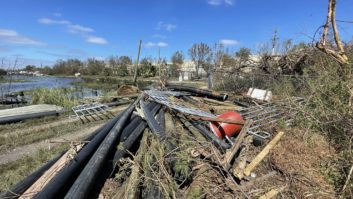
Even if you do not read the newspaper or listen to the radio, you know that there is uncertainty in the broadcast industry.
While you may still have a job, you are experiencing the consequences of broken business models and economic meltdown. This article does not promise yet another self-help solution. We do not choose the decade we live in, and there is usually little that one can do to bring back the “good old days.”
Nevertheless, it is useful to consider some of the hidden consequences of the environment that we find ourselves immersed in.
In the previous Last Word article (RWEE, April 15), I introduced two concepts: a human being as an element in a social system, and the need to acquire the soft skills to manage that system.
In addition to being in a social system, we are each a biological system composed of thousands of elements that have evolved to work together. Your foot, your stomach and your eyes are obvious examples of elements with specialized function in you as a system. But there are also thousands of hidden elements that are critical to your ability to function. Although you cannot see these components, they are there and critical for survival.
While we may experience ourselves as a “holistic” me, this is not a useful model when trying to survive in a hostile environment. You are a system. In the same way, an automobile, a broadcast station and an RF transmitter are systems. A good engineer understands the difference between an element and a system. Recent research is now showing how the biological elements in you as a system respond to the dynamics of life.
INSTRUCTION MANUAL
When you purchase a transmitter, the manufacturer provides a user’s manual and literature on how to maintain and repair it. The designer of the system makes assumptions about how it should function, and ideally, its properties are articulated as limitations in performance under various conditions. Run the final stage of a transmitter at 50 percent over its power rating for a day and it is likely to burn out. Standard 14/2 electrical wire can handle 100 amps for a short time, but if the current continues, your house will burn down. Run your heart at 100 percent over its normal rating for a week, and it may also burn out.
During the trailing days of World War II, afterburners were installed in jet airplanes. These devices injected excess fuel into the exhaust to provide a short-term boost in power, like the boost required for an animal running for its life from a lion. In effect, the engine was run beyond its rating, and continuous use of the afterburner would destroy the engine.
Similarly, if you run a 26.2-mile marathon, you will need weeks of rest to allow for healing in the overloaded muscles and heart. Legend has it that in 490 B.C. the original Marathon runner, who carried the news of the Greek victory over the Persians, died shortly after reaching his destination. Overload has a cost.
Over the centuries, intuitive wisdom has created a set of ad hoc rules for the limitations of the biological elements in the human system. These rules are constantly in flux, and history usually showed that they were wrong. But during the last decade, rapid advances in cognitive science, evolutionary biology and medical technology are now providing reliable data about the dynamics of the elements in our biological system.
STRESSOR EFFECTS
What happens when our biological system is placed into an engineering laboratory in a broadcast station in the 21st century? Obviously, the system did not evolve for that purpose. Your body does not necessarily distinguish between an ominous lion and a pending layoff; both are experienced as danger.
In simple terms, all species evolved a unique mechanism for avoiding danger. To one degree or another, every animal has one of three choices for handling a threat: fight, flight or freeze.
Human beings also respond in this way. We fight to keep our jobs or for a promotion. Or, when times are tough, we take flight to another industry or a different life style, or hide with our head in the sand avoiding any actions that might attract attention. We can now look more carefully at how our biological system responds to threats and stressors.
Nature used one critical idea in designing biological systems. If you are being chased by a lion, activate all elements beyond their ratings in order to avoiding being the lion’s lunch. It does not matter how much that overload damages elements in the system because the alternative is far worse. Better to allow a week for recuperation than to be eaten.
At this point, you might be wondering why this discussion is relevant to those of us who are working in the broadcast industry. The answer is that for many (most) of us, our work environment has stressors, which produce a stress response to protect us from real or imagined danger.
We may experience 21st century dangers on a 24/7 basis, though we were not designed to handle continuous stressor threats. You may be lying in bed at 2 a.m. trying to plan how you will avoid the impending layoffs. This is biologically equivalent to being chased by a lion. However, with a real lion, after a short time, you are either safe or dead. The threat is short-lived, overloading our internal components for a short time, like the afterburner. But we are not designed to handle threats for weeks, months or years.
Like all mammals, many of our biological elements respond to stressors. I will take an example of a single organ — the heart.
Under stress, your sympathetic nervous system signals to all organs to enter survival mode, releasing a special hormone, glucocorticoid, to communicate urgency to the other organs. Your heart shifts into high gear, beating faster with increased pumping pressure. Your veins constrict and arteries expand to feed blood to muscles while shutting down blood to non-essential organs. Your kidneys are told to stop extracting water to avoid dehydration due to a loss of blood. Digestion stops, the immune system shuts down, memory is impaired, sleep becomes impossible … the list goes on.
These stress responses are not a problem if activated for only a short interval. But the body falls apart if they continue indefinitely.
RESPONSE TO STRESSORS
I strongly recommend taking a look at Robert Sapolsky’s book, “Why Zebras Don’t Get Ulcers.” It explores the consequence of stress: stress-related diseases. He also proposes coping mechanisms. Managing stress is yet another of the soft skills that are critical for survival.
Sapolsky’s simple recommendation is to experiment with yourself until you find a technique that reduces the “experience” of stress. It can be meditating, taking long walks, playing with a grandchild or whatever. But if you do not find some way to throttle back your response to stressors, you will destroy your internal organs.
None of us can change the world, but we can and should change our response to it. Reinhold Niebuhr wrote a famous prayer: “God grant me the serenity to accept things that I cannot change, courage to change the things that I can, and the wisdom to know the difference.” Alternatively stated, you can rarely change the external world, but you can always change your inner world.
My personal method of reducing stress is spending time with close friends, colleagues and family. This is more than just socializing with the gang. I get the benefit of the comfort from being connected to a supportive community with sympathy, empathy and a shared view of mutual assistance and caring. People are social animals that gain from cohesion. Also, I am an executive of an equipment manufacturer that was created entirely on the basis of enhancing the well-being of the staff as the only currency.
It really does work.
The author is director of engineering for 25-Seven Systems.












